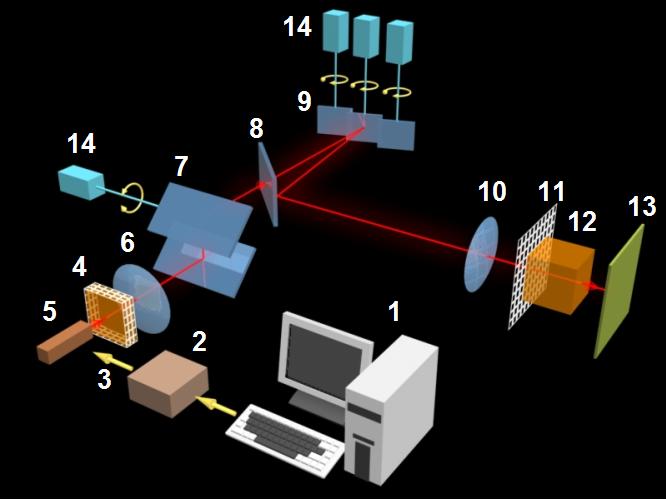Holographic_Display
4.4 Holographic Display
News of the touchless holographic interface comes from HoloTouch. In conjunction with Atlantex Corp., HoloTouch has produced the BeamOne, a device that allows operators to enter data by passing a finger through holographic images of "keys" projected into the air. The device also can project holographic keyboards and other "touchable" icons. For details, point your browser to www.holodemo.com (David, 2004).
Technology of electronic interactive three-dimensional displays is already very popular in sci-fi, but scientists only recently created the first true holovideo.
3D displays are able to create three-dimensional image of computer graphics, but they fail in offering one or more visual simulations of three-dimensionality (for example, shading, more detailed display of structures, simulation of three-dimensional overlapping).
Only real time electronic holographic display (holovideo) makes it possible to create the realistic three-dimensional image of computer graphics with all attributes of three-dimensionality.
Electro holographic display generates three-dimensional holographic image. Process of image generation involves several steps we can divide into two main processes: computing, where three-dimensional image of object is converted on holographic fringe and optical, where the light is transformed by fringe (Lucente, Galyean, 1995).
Problems with the computation of fringes and optical changes are caused by the enormous amount of information which holography requires. Instead of approaching the image as a pixel field with gaps of approximately 100 micrometers, as is common in two-dimensional display, the holographic display has to compute the holographic fringe with amplitude gaps of approximately 0.5 micrometers to cause the modulated light to diffract and create three-dimensional image.
In the case of holographic display, the image changes continually and we see various objects from various directions exactly as in real surroundings. In principle, the screen of our device is seen as a hologram. Each and every one of its points works like the model of a window. These points are the pixels, and when speaking about 3D display, we call them volume pixels, in other words, voxels. Inside the device we produce light beams with complex light modulation technique, in special geometric arrangements. With appropriate control it is possible to make the light beams propagate in such direction as if they were leaving from a point behind the hologram screen or as if they were crossing at a point in front of the screen. From these beams the hologram screen composes a continuous image. The result is a virtual 3D object that can even be looked at without glasses or any other special aid.
Electro holographic display working in real time is able to create dynamic 3D images with the highest quality of three-dimensionality simulation and reality of images. When positioned in the viewing zone, the viewer sees a 3-D image in the display. The input signals are generated by a computer. The size and complexity of interference fringe patterns often precludes their computation in the interactive approach in real time. In the field of computational holography, a continuous pattern of interference fringes is generated by numerically simulating the propagation and interference of light. A computer-generated hologram must contain a great number of fringes.
The first holovideo display created small images that needed several minutes of calculation for every change. New approaches, such as holographic compressions of the band width and faster hardware enable the interactive calculation and promise an increase in velocity and complexity of displayed holovideo images.
The new holographic displays will have to improve in velocity of generation (computation) of holograms.
The principle of holographic display operation is illustrated in Fig. 4–1.

1 – computer, 2 – RF processor, 3 – RF signal, 4 – acoustic-optical modulator, 5 – laser, 6 – lens, 7 – vertical scanner, 8 – beam splitter, 9 – horizontally connected scanners, 10 – output lens, 11 – dispersion window (ground-glass), 12 – display area, 13 – display plane, 14 – drive
The computer (1) generated fringes enter the radio-frequency processor (2) that encodes them into the radio-frequency signal (3) and this signal then enters the acoustic-optical modulator (AOM) (4). A hologram is created by more channel acoustic-optical modulator (4) where a beam from laser light (5) is paralelly modulated in each channel by acoustic vibrations acting on the crystal that is located in front of focusing lens (6). These beams are directed to the vertical scanner (7) then they pass through the beam splitter (8). Each part goes to three from the six horizontally connected scanners (9) from where they are reflected to the output lens (10) and then they are incident on the ground-glass (11) where it is possible to observe this image.
The technology of holographic displays is in the stage of research. The future promises faster calculations, optical modulation of higher band width and improved processing of holographic information.
Three-dimensional displays find the application in such the fields as the computer design, scientific visualisation of more-dimensional data, teleoperations, trainings and education (holographic virtual books about anatomy, molecules or machines), virtual examinations, architecture, development and simulation of cars and planes, molecular technology, air navigation, games of virtual reality.
By today’s modern medical imaging methods, such as the 3D ultrasound, CT the MRI and others, we can create so called 3D images. As a result of perspective, light and shadow effects these images give graphic displays of anatomic structures, but in reality these are only two dimensional, flat images. However, they are not so comfortable to the user, and watching them for a longer period of time can even be tiring.
Compared to these systems, the real-time holographic display can bring revolutionary changes. It is also an advantage that you don’t have to learn how to work with special equipment, because the method uses the natural viewing function we have already learnt as babies.
The 3D display is possible to apply in testing blood-vessels, diagnosing tumours, brain diseases, digestion system or in traumatology, simply, it is the best possible way of localising the unwanted change. (www.holographka.com, 2002).


